Simulation Design of Surface Acoustic Wave Sensor Based on Langasite Coplanar Integration with Multiple Parameters
Abstract
:1. Introduction
2. Calculation Principle and Data Preparation
3. Analysis of Simulation Results
3.1. Temperature Sensor Simulation
3.2. Pressure Sensor Simulation
3.3. Vibration Sensor Simulation
3.4. Simulation Design of Multi-Parameter Integrated Sensor
4. Conclusions
Author Contributions
Funding
Data Availability Statement
Conflicts of Interest
References
- Asseko Ondo, J.C.; Blampain, E.J.J.; N’Tchayi Mbourou, G.; Mc Murtry, S.; Hage-Ali, S.; Elmazria, O. FEM Modeling of the Temperature Influence on the Performance of SAW Sensors Operating at GigaHertz Frequency Range and at High Temperature Up to 500 °C. Sensors 2020, 20, 4166. [Google Scholar] [CrossRef] [PubMed]
- Donohoe, B.; Geraghty, D.; O’Donnell, G.E. Wireless Calibration of a Surface Acoustic Wave Resonator as a Strain Sensor. Sens. J. IEEE 2011, 11, 1026–1032. [Google Scholar] [CrossRef]
- Weng, H.; Duan, F.L.; Zhang, Y.; Hu, M. High Temperature SAW Sensors on LiNbO3 Substrate with SiO2 Passivation Layer. IEEE Sens. J. 2019, 19, 11814–11818. [Google Scholar] [CrossRef]
- Floer, C.; Elmazria, O.; Naumenko, N.; Bartoli, F.; Ghanbaja, J.; Aubert, T.; Hage-Ali, S. AlN/Pt/LN-Y128 packageless acoustic wave temperature sensor. IEEE Trans. Ultrason. Ferroelectr. Freq. Control. 2021, 68, 2315–2318. [Google Scholar] [CrossRef] [PubMed]
- Habib, Z.; Parthasarathy, R.; Gollahalli, S. Performance and emission characteristics of biofuel in a small-scale gas turbine engine. Appl. Energy 2010, 87, 1701–1709. [Google Scholar] [CrossRef]
- Mills, A.R.; Kadirkamanathan, V. Sensing for aerospace combustor health monitoring. Aircr. Eng. Aerosp. Technol. 2019, 92, 37–46. [Google Scholar] [CrossRef]
- Tian, X.G.; Liu, H.; Tao, L.Q.; Yang, Y. High-resolution, high-linearity temperature sensor using surface acoustic wave device based on LiNbO3/SiO2/Si substrate. AIP Adv. 2016, 6, 095317. [Google Scholar] [CrossRef] [Green Version]
- Binder, A.; Bruckner, G.; Schobernig, N.; Schmitt, D. Wireless Surface Acoustic Wave Pressure and Temperature Sensor with Unique Identification Based on LiNbO3. IEEE Sens. J. 2013, 13, 1801–1805. [Google Scholar] [CrossRef]
- Borrero, G.A.; Bravo, J.P.; Mora, S.F.; Velásquez, S.; Segura-Quijano, F.E. Design and fabrication of SAW pressure, temperature and impedance sensors using novel Multiphysics simulation models. Sens. Actuators A Phys. 2013, 203, 204–214. [Google Scholar] [CrossRef]
- Müller, A.; Konstantinidis, G.; Giangu, L.; Adam, G.C.; Stefanescu, A.; Stavrinidis, A.; Stavrinidis, G.; Kostopoulos, A.; Boldeiu, G.; Dinescu, A. GaN Membrane Supported SAW Pressure Sensors with Embedded Temperature Sensing Capability. IEEE Sens. J. 2017, 17, 7383–7393. [Google Scholar] [CrossRef]
- Martin, G.; Berthelot, P.; Masson, J.; Daniau, W.; Blondeau-Patissier, V.; Guichardaz, B.; Ballandras, S.; Lamber, A. Measuring the Inner Body Temperature using a Wireless Temperature SAW-sensor-based System. In Proceedings of the IEEE Ultrasonics Symposium, Rotterdam, The Netherlands, 18–21 September 2005. [Google Scholar]
- Zhang, Y.; Tan, Q.; Zhang, L.; Zhang, W.; Xiong, J. A novel SAW temperature-humidity-pressure (THP) sensor based on LiNbO3 for environment monitoring. J. Phys. D Appl. Phys. 2020, 53, 375401. [Google Scholar] [CrossRef]
- Xu, F.; Tao Xue, T.; Liang, X.; Tan, Q. High-temperature direct bonding of langasite using oxygen plasma. Scr. Mater. 2021, 194, 1113681. [Google Scholar] [CrossRef]
- Seifert, M.; Rane, G.K.; Kirbus, B.; Menzel, S.B.; Gemming, T. Surface Effects and Challenges for Application of Piezoelectric Langasite Substrates in Surface Acoustic Wave Devices Caused by High Temperature Annealing under High Vacuum. Materials 2015, 8, 8868–8876. [Google Scholar] [CrossRef] [PubMed] [Green Version]
- Zhang, C.; Ghosh, A.; Zhang, H.; Shi, S.Q. Langasite-based surface acoustic wave resonatoror acetone vapor sensing. Smart Mater. Struct. 2020, 29, 015039. [Google Scholar] [CrossRef]
- Xu, F.; Tan, Q. Langasite micromachining technology applied to surface acoustic wave sensors in ultra-high temperatures. In Proceedings of the 34th IEEE International Conference on Micro Electro Mechanical Systems, Gainesville, FL, USA, 25–29 January 2021. [Google Scholar]
- Li, Y.; Lu, W.; Zhu, C.; Liu, Q.; Zhang, H.; Lei, B. Finite element analysis of surface acoustic wave based on a micro force sensor. Measurement 2015, 65, 112–119. [Google Scholar] [CrossRef]
- Tigli, O.; Zaghloul, M.E. Finite Element Modeling and Analysis of Surface Acoustic Wave Devices in CMOS Technology. IEEE Trans. Compon. Packag. Manuf. Technol. 2012, 2, 1021–1029. [Google Scholar] [CrossRef]
- Xie, B.; Ding, F.; Dong, Z.; Shang, H.; Huang, D.; Gu, H. FEM analysis of piezoelectric film as IDT on the diamond substrate to enhance the quality factor of SAW devices. Diam. Relat. Mater. 2020, 102, 107659. [Google Scholar] [CrossRef]
- Moulzolf, S.C.; Behanan, R.; Lad, R.J.; da Cunha, M.P. Langasite SAW Pressure Sensor for Harsh Environments. In Proceedings of the 2012 IEEE International Ultrasonics Symposium, Dresden, Germany, 7–10 October 2012. [Google Scholar]
- Sakharov, S.; Kondratiev, S.; Zabelin, A.; Naumenko, N.; Azarov, A.; Zhgoon, S.; Shvetsov, A. Theoretical and experimental investigation of langasite as material for wireless high temperature SAW sensors. In Proceedings of the 2010 IEEE International Ultrasonics Symposium, San Diego, CA, USA, 11–14 October 2010. [Google Scholar]
- Bigler, E.; Hauden, D.; Theobald, G. Stress-sensitivity mapping for surface acoustic waves on quartz. IEEE Trans. Ultrason. Ferroelectr. Freq. Control 1989, 36, 57–62. [Google Scholar] [CrossRef]
- Hietala, S.L.; Hietala, V.M.; Brinker, C.J. Dual SAW sensor technique for determin-ing mass and modulus changes. IEEE Trans. Ultrason. Ferroelectr. Freq. Control 2001, 48, 262–267. [Google Scholar] [CrossRef]
- Lee PC, Y.; Liu, N. Plane harmonic waves in an infinite piezoelectric plate with dissipation. IEEE Trans. Ultrason. Ferroelectr. Freq. Control 2004, 51, 1629–1638. [Google Scholar]
- Chung, G.-S.; Phan, D.-T. Finite Element Modeling of Surface Acoustic Waves in Piezoelectric Thin Films. J. Korean Phys. Soc. 2010, 57, 446–450. [Google Scholar] [CrossRef]
- Dubowski, J.J. Laser Applications in Microelectronic and Optoelectronic Manufacturing II. Proc. SPIE 1997, 3618, 1419–1431. [Google Scholar]
- Koskela, J.; Plessky, V.; Willemsen, B.; Turner, P.; Hammond, B.; Fenzi, N. Hierarchical Cascading Algorithm for 2-D FEM Simulation of Finite SAW Devices. IEEE Trans. Ultrason. Ferroelectr. Freq. Control 2018, 65, 1933–1941. [Google Scholar] [CrossRef] [PubMed]
- Askari Farsangi, M.A.; Saidi, A.R.; Batra, R.C. Analytical solution for free vibrations of moderately thick hybrid piezoelectric laminated plates. J. Sound Vib. 2013, 332, 5981–5998. [Google Scholar] [CrossRef]
- Locke, S.; Sinha, B.K. Acceleration Stress Compensated Surface Acoustic Wave Devices. IEEE Trans. Ultrason. Ferroelectr. Freq. Control 1987, 34, 478–484. [Google Scholar] [CrossRef]
- Hana, P.; Linhart, J.; Burianova, L.; Zhang, S.; Mikulickova, L. Influence of Electric Field, Temperature and Pressure on Hydrostatic Piezoelec- tric Coefficient of x(Bi0.5Na0.5)TiO3–y(Bi0.5K0.5) TiO3–pB-aTiO Lead-Free Ferroelectric Ceramics. Ferroelectrics 2014, 463, 65–71. [Google Scholar] [CrossRef]
- Zhang, G. Research on Surface Acoustic Wave Pressure Sensor Based on LGS. Diploma Thesis, Shanghai Jiao Tong University, Shanghai, China, 2003. [Google Scholar]
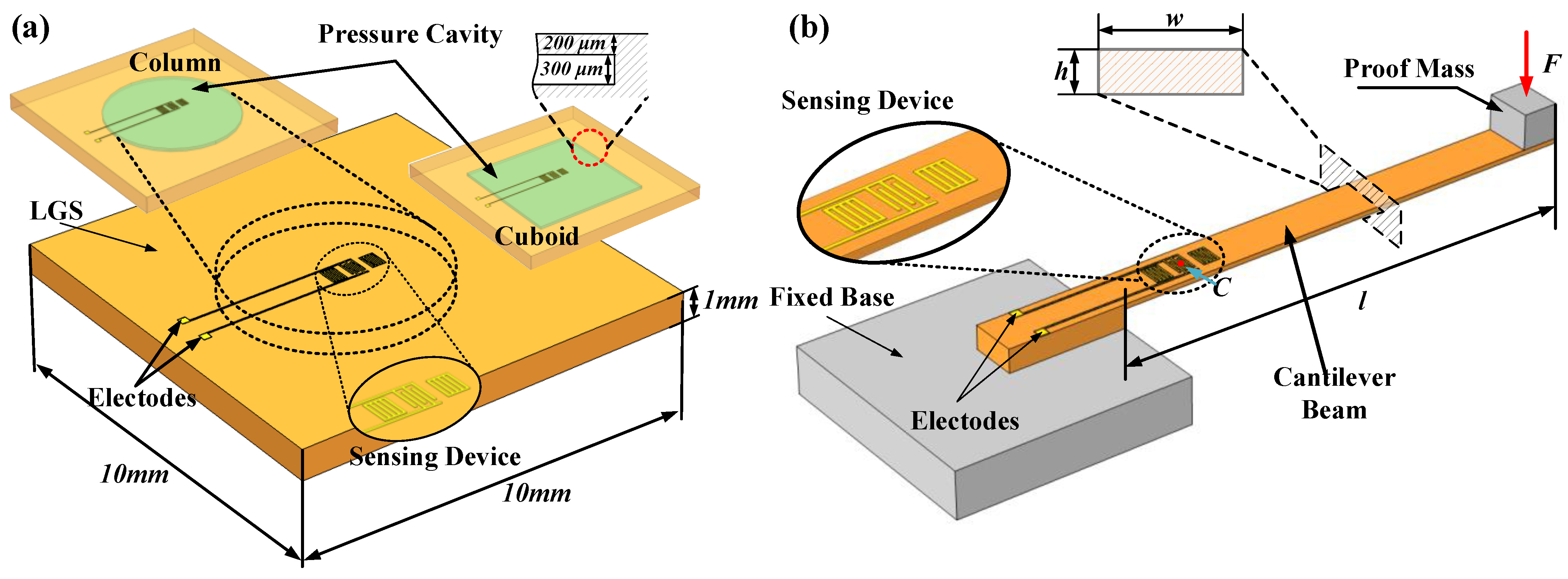
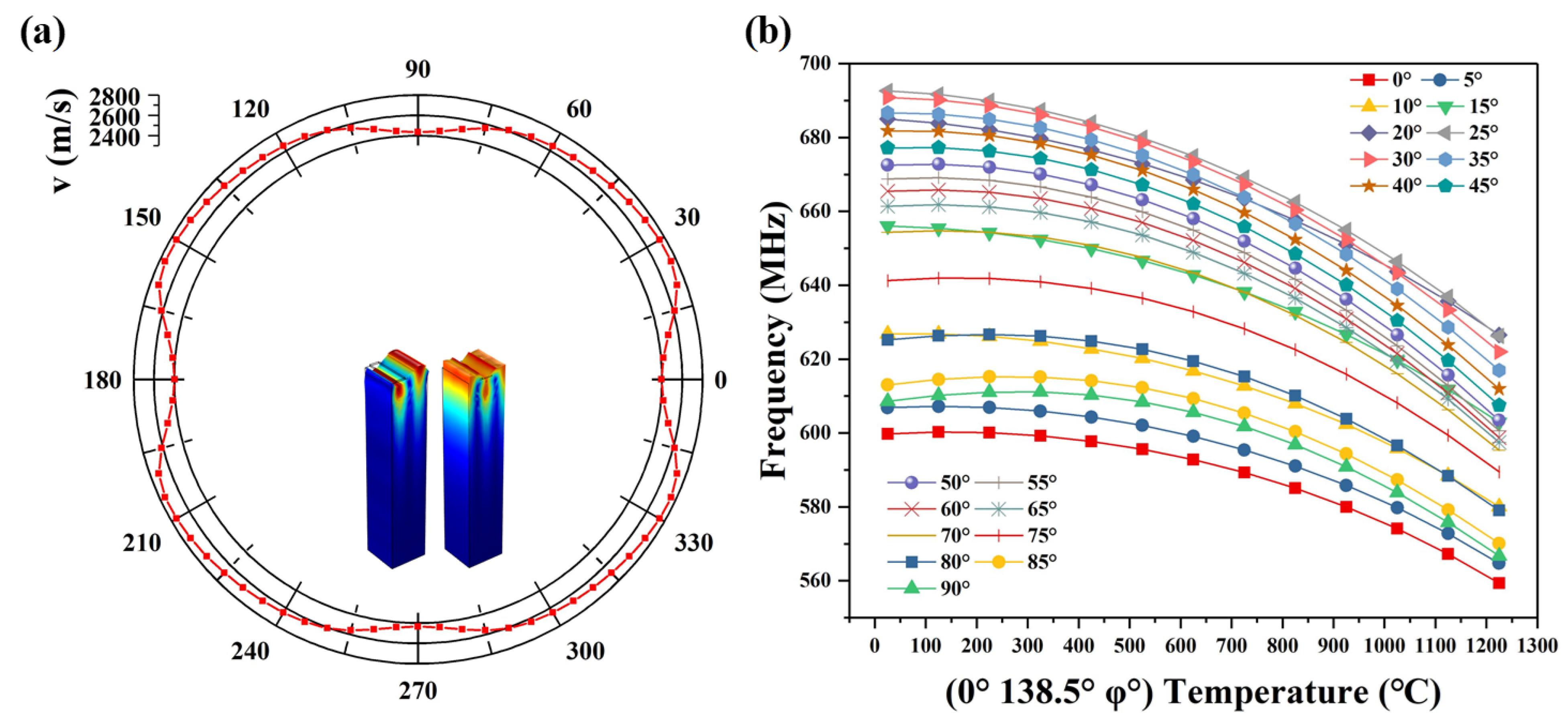
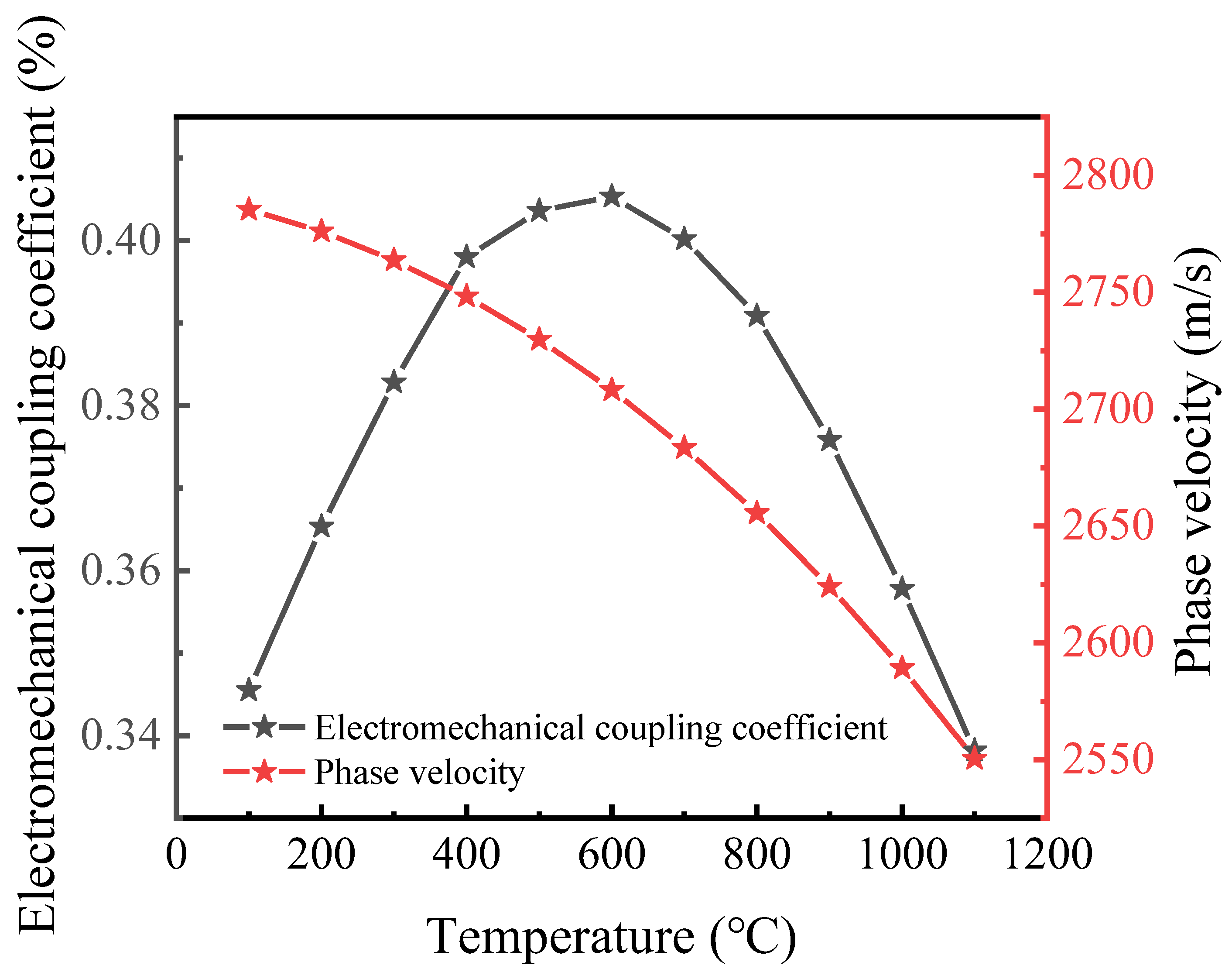
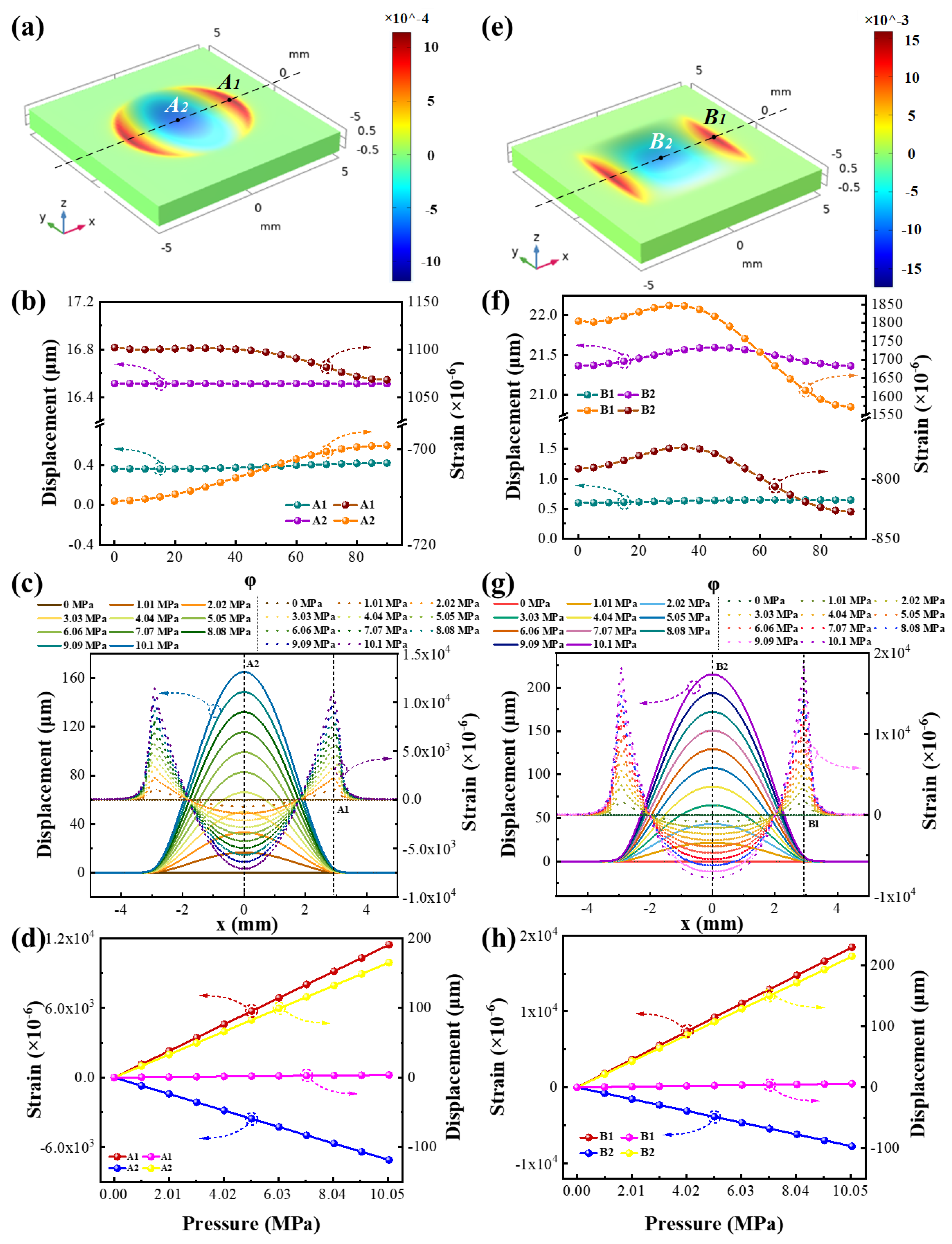
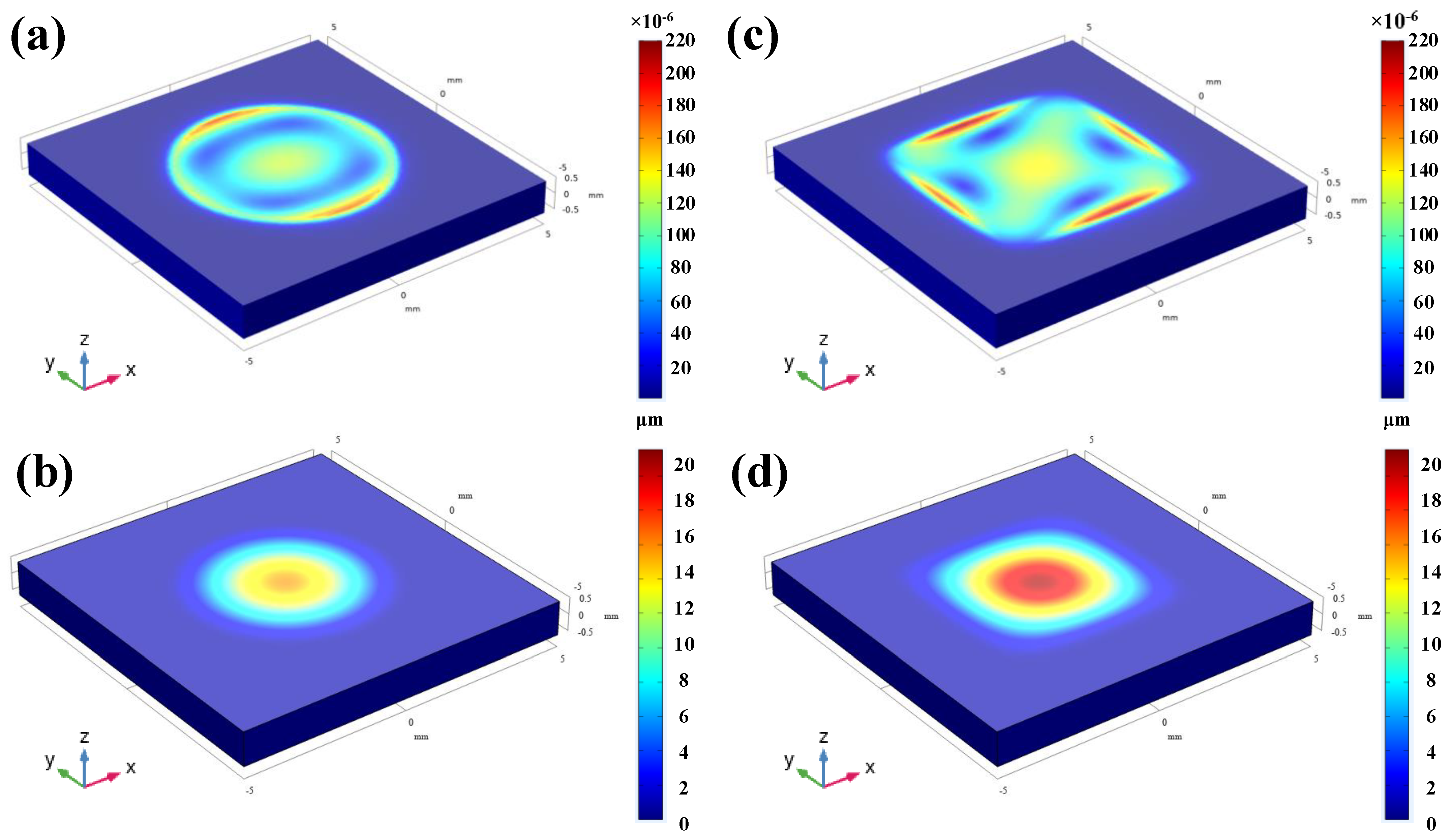

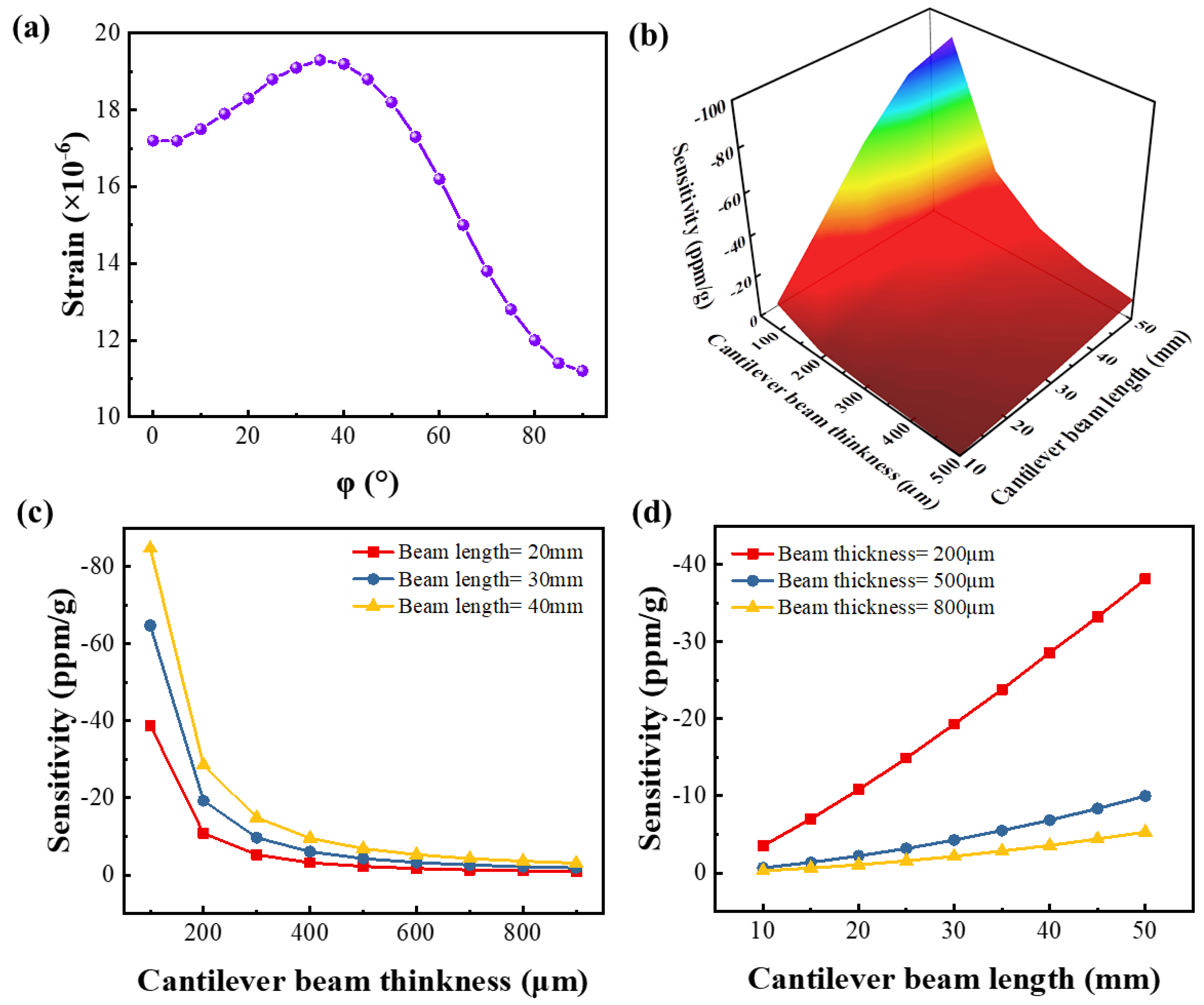
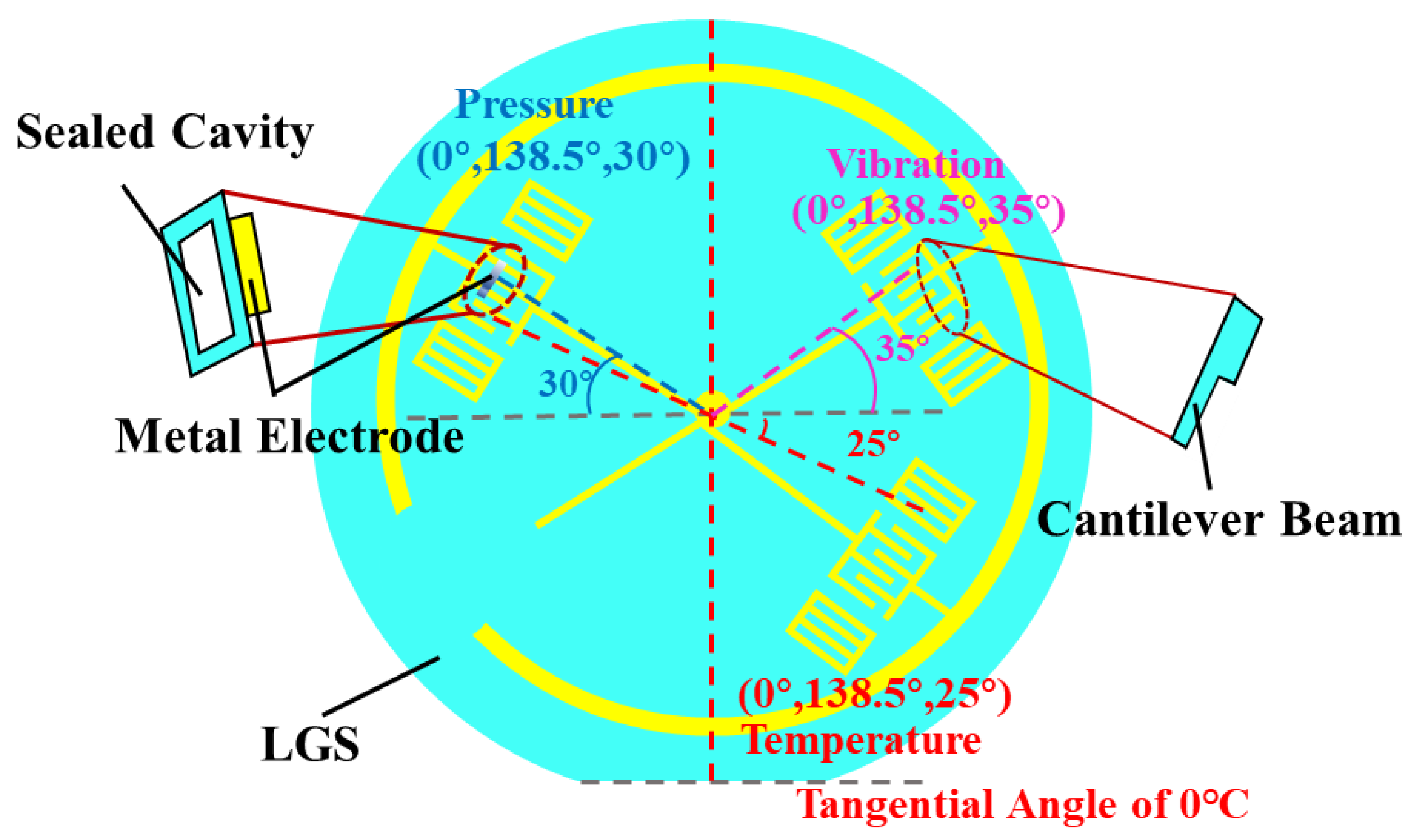

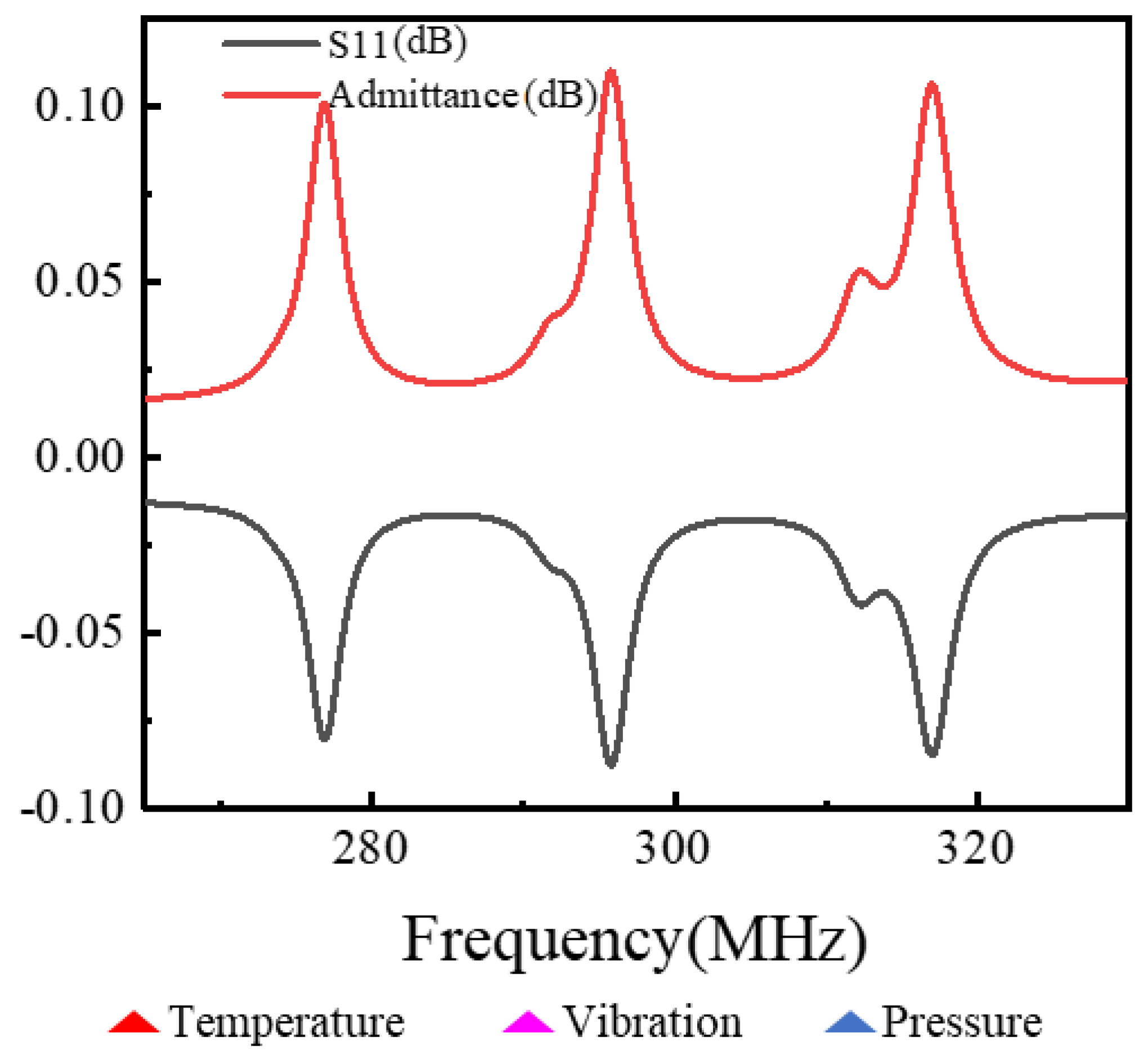
| Material Constants | Absolute Quantities | Temperature Coefficients 1st 10−6/K | Temperature Coefficients 2nd 10−9/K | |
|---|---|---|---|---|
| Elastic constants [×109, N/m2] | C11E | 189 | −58.4 | −82.7 |
| C12E | 104 | −98.7 | −51.9 | |
| C13E | 102 | −82.3 | −68.1 | |
| C14E | 14.40 | −307.0 | 95.5 | |
| C33E | 268 | −105.0 | −89.7 | |
| C44E | 53.3 | −58.7 | −103.6 | |
| Piezoelectric constant [C/m2] | e11 | −0.438 | 464.5 | −427.5 |
| e14 | 0.104 | −700.3 | 1600 | |
| Dielectric constants | ε11/ε0 | 19.06 | 135.5 | 118.0 |
| ε33/ε0 | 51.60 | −783.4 | 661.2 | |
| Coefficient of thermal expansion [ppm/K] | α11 | 5.08 | - | - |
| α33 | 3.49 | - | - | |
| Density [kg/m3] | ρ | 5743 | −15.71 | - |
| Parameters | Values |
|---|---|
| SAW wavelength (λ, μm) | 4 |
| Width of IDT (μm) | 1 |
| Pt Electrode thickness (nm) | 150 |
| Metal ratio | 0.5 |
| Aperture | 50 λ |
| TCF (ppm/k) | −15.8 |
Publisher’s Note: MDPI stays neutral with regard to jurisdictional claims in published maps and institutional affiliations. |
© 2022 by the authors. Licensee MDPI, Basel, Switzerland. This article is an open access article distributed under the terms and conditions of the Creative Commons Attribution (CC BY) license (https://creativecommons.org/licenses/by/4.0/).
Share and Cite
Liang, X.; Zhang, Y.; Xu, F.; Tan, Q.; Zhang, J. Simulation Design of Surface Acoustic Wave Sensor Based on Langasite Coplanar Integration with Multiple Parameters. Micromachines 2022, 13, 705. https://doi.org/10.3390/mi13050705
Liang X, Zhang Y, Xu F, Tan Q, Zhang J. Simulation Design of Surface Acoustic Wave Sensor Based on Langasite Coplanar Integration with Multiple Parameters. Micromachines. 2022; 13(5):705. https://doi.org/10.3390/mi13050705
Chicago/Turabian StyleLiang, Xiaorui, Yongwei Zhang, Fangmeng Xu, Qiulin Tan, and Juan Zhang. 2022. "Simulation Design of Surface Acoustic Wave Sensor Based on Langasite Coplanar Integration with Multiple Parameters" Micromachines 13, no. 5: 705. https://doi.org/10.3390/mi13050705






